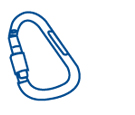How
do I progress?
After your first jump, you will surely be dying to get back in the
sky to do it all again. Luckily, you’ve already had all the
training so subsequent jumps will cost only £20! When you
have done two good Static Line jumps, you will progress onto Dummy
Pulls. These jumps allow you to demonstrate to the instructor that
you are able to deploy your own parachute while still having it
deployed by a static line. A flag or similar is placed in the same
place as a ripcord and all you have to do is pull it out after you
have exited the plane (it’s not quite that simple but you
get the idea!). When you have done this three times you progress
onto freefall.
This is when skydiving gets really exciting as you have to pull
the ripcord to deploy your parachute. A common worry is that you
might “forget to pull the ripcord” but don’t worry
– this never happens! Once you leave the plane there is nothing
that could stop you pulling the ripcord! You begin with a short,
4 second freefall and then progress onto 10 and 15 second freefalls.
By this point you are using your altimeter to determine when to
pull and can start learning how to perform turns, backloops and
forward movement (which is called tracking). For these jumps you
be leaving the aircraft at 12,000 feet.
When you have
mastered these techniques you have to put them all together on one
jump after which you are awarded your Cat 8. This means you are
qualified as a solo parachutist and don’t need instructors
supervising you any more. Now you can jump with your friends and
jump at dropzones anywhere around the world.
BACK
|








